I am always on the look out for new spots from which to look out over London and take photos. Last week, I discovered another such place, on the roof of something called One New Change, which is a big new shopping centre right next to St Paul’s Cathedral. The weather during the last few weeks has mostly been vile but during a brief break in this weather, I journeyed to One New Change to check it out, and in particular to see if I could go up to its roof and take photos. Internet omens seemed good, but you never really know about such things until you get there.
Here is the entrance I used to get inside One New Change:
Click on any of these pictures if you want to see them bigger.
Modernist architects used to be fond of a phrase to the effect that form should follow function. But the truth is that when it comes to architecture, form tends to follow not function but fashion.
To be fair to the architects, fashion tends also to follow what is technologically possible. At any given moment in modern architectural history, architects have asked themselves: what does building technology now enable us to do which we couldn’t do half a decade ago, thus enabling us to get passers-by to say: Wow, look at that. Is it fair to call this “fashion”? I think so. After all, that is surely how the fashion business itself tends to operate.
So it is with One New Change. Only if you already knew, as I already knew when I went looking for it, would you have known that this is a shopping centre. It could have been a university, an office block, an “arts” or “community” centre, a library, or any one of half a dozen other things. But, you can tell at once that it was only very recently constructed, because here is a building done in the planes of glass at bizarre angles style. Which is a very recent architectural fashion. (One of the growth service industries of our time is presumably specialist window cleaning, of windows that are not easily reached by the usual methods of simply hanging a platform out over the vertical edge of a building and then just going up and down and side to side.)
Where did this style come from? Much of it, as I say, is a case of “because we can”. Glass has got a lot stronger and cleverer in recent years, as have building materials generally. And now that architects have computers to keep track of everything, they can design – and more to the point can build – buildings made in these bizarre shapes.
Another influence at work on modern architecture generally and One New Change in particular is, I surmise, ships. Modernist architects have always been envious of and heavily influenced by ship designers, because with ships, form really does have to follow function, far, far more than is the case with most buildings. Many a nineteen thirties block of flats, with its long horizontal outdoor walkways and curved corners, was designed by an architect with his head full of ocean liner imagery.
More recent ships, of the stealth sort, now offer further “inspiration”. My first reaction to One New Change was that here was a building that was trying to avoid being spotted on anyone’s radar. Which is a very reasonable thing for a building to want to do if it is only a stone’s throw from St Paul’s Cathedral.
So anyway, I went in through this entrance, and found escalators, and a big lift shaft. I decided to try the lift. Early indicators, in the form first of the lift, and then in the form of this very striking view of St Paul’s from this lift, were very good:
That’s a rather wonkily angled photo, what with the lift being in motion and me having only one go at it. Plus, it looks misleadingly dark, on account of me looking towards the afternoon sun. But I like it anyway, because of the sky and the reflections and St Paul’s.
Nobody tried to stop me getting into this lift, as the somewhat warlike appearance of the outside the building was perhaps subconsciously suggesting to me might have happened. I just pushed the usual buttons, just as in any other shopping centre, or for that matter big department store, and up I went.
The lift itself, made from reassuringly solid slabs of that new and clever glass that I have already mentioned, was clearly designed with the viewing experience of those travelling in it very much in mind. It isn’t buried in a lift shaft. Rather is it hung out on the inside of the building, as happens in grand American hotel lobbies that you see in movies. And a slice has been cut from top to bottom through the building to enable St Paul’s to be visible from this lift, throughout one’s ascent. All of which strongly suggested that a similar concern for viewing pleasure might also prevail at the top of the building. The lift rose upwards, and my level of photographic optimism rose with it.
When I got to the top, nobody made me buy a ticket or tried to check my bag or any such thing. And I was right to be photographically optimistic:
Wow. Again with the misleadingly dark feel, because this is pointing in the same direction as the previous photo from the lift. But, what an amazing place. The roof of One New Change looks even more like a ship trying to avoid having a radar signature than it does near the ground.
Now here’s the view looking back the other way. The glass box is the top of the lift.
This next picture reinforces the impression of a building that is, so to speak, ship shape:
My feeling about viewing platforms from which to look out over London is that I am willing to trade vertical height for horizontal length. A spike high into the sky, like the Monument or like the tower of Westminster Cathedral, can be good. But the advantage to me of an elongated platform, even such a thing as a railway platform that merely happens to be at inner suburban roof level, is that I can walk along it, and photographically align those Big Things, seeing this Thing from here, that one from there, and so on. Move twenty yards, and a Big Thing that had been hidden by a smaller, nearer lump (London contains many smaller lumps) can come into view.
The platform at the top of One New Change, or “deck” as I would prefer to call it, what with its maritime feeling, is, as you can already see from above photos, not that high. It is not nearly as high, to take just one very obvious example that you can clearly see from it, as either of the two viewing galleries at the top of St Paul’s, around and above the dome. The biggest button number in that lift was a mere six. That’s six big shopping centre floors rather than six office floors, but it still isn’t very high. All you are really doing is poking your head above the regular height of London’s urban architectural vernacular, before the late twentieth century lust for non-ecclesiastical height kicked in. You feel as if you are sailing through the random architectural sea that is London, rather than flying above it.
Personally I loved the views I was able to see from this relatively low level, but these views don’t really give you a clear idea of the shape of London (in the way that the views from the top of the Pompidou Centre show you the shape of Paris). In particular, you don’t see anything of the river, or its bridges, just the occasional building that, if you know London, you know to be next to the river, on the far side.
Here, for example is a shot of that new three-eyed tower that I am very fond of:
But see also that ye-olde half-timbered white thing with a thatched roof, hiding in among all the intervening muddle. That’s the new-old Globe Theatre, recently mentioned here by Johnathan Pearce.
Or, consider this snap, which I thought at the time was just of the Wheel plus surrounding lumps, plus that big St Paul’s Thing at the front of course. But look how the top of Big Ben is to be seen nestling in among it:
I will definitely return to the roof of One New Change, to see what further Big Thing alignments and smaller oddities and amusements I can observe. And when the place is less crowded with unwinding city toilers than it was when I went last week, I will also check out the bar, and find out if anything can be seen of such things as the Gherkin (which you can just see the top of in one of the photos above) and the Docklands towers, to the east. Most of what I saw on my trip was from looking south, and a bit to the West, which is rather less interesting.
In addition to photoing London’s Big Things, I like also to photo my fellow digital photographers, doing such things as lining themselves up with Big Things, which is presumably what is happening here:
And then there are the signs. Everywhere in Britain now, there are signs, warning against every sort of danger, from ludicrously obvious to ludicrously far-fetched. I particularly liked this one:
“Beyond barrier please do not climb.” Sounds like this guy.
Despite all the excellent views, the thing that most impressed me about my first trip to the roof of One New Change was not so much what you could see from it as the place itself. So my final picture here concentrates on that, and on how beautifully big this viewing deck is:
I can’t see such an appealing place remaining this uncrowded for long.
And yes, that is the Shard, again. The more I see of the Shard, the more I like it. The one truly ugly thing about the Shard, I think, is how it draws attention to that hideous Brutalist lump next to it. (Which, I have just learned, is about to get a partial facelift.) There are complaints that a few London views are being spoilt by the Shard, notably that of St Paul’s from the hills to the north of London (Parliament and Primrose). Maybe so, although I personally now like these views even more. And I reckon the Shard makes the view in my above snap, as it does many other London views, many times better.
And yes, of course, the Shard was built with foolish boom-bust money, but at least London has some handsome Big Things to show for that foolish time, of which the Shard is, in my opinion, one of the very best.
While finishing this posting, I mentioned to a friend what it is about, and he said Prince Charles had had something to do with the design of One New Change. It seems that he tried to stop it.
Plus: I am not the only one who thinks stealth (see para two there) when encountering this building.
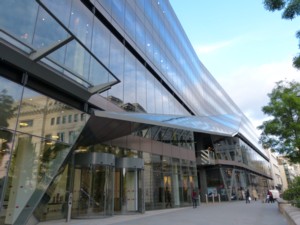
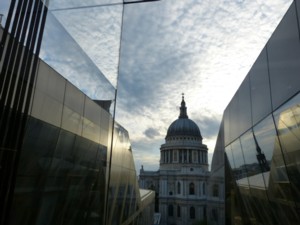
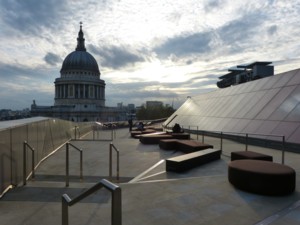
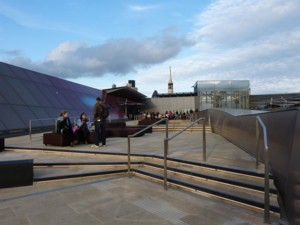
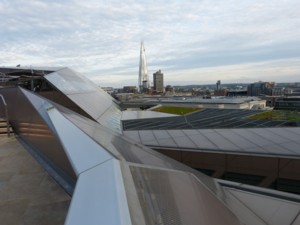
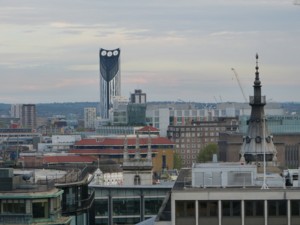
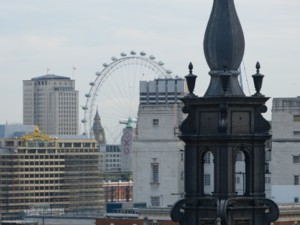
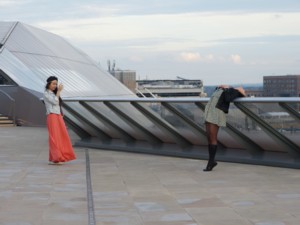
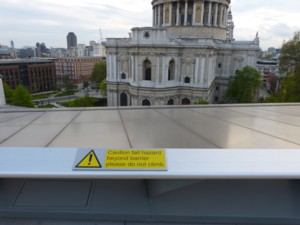
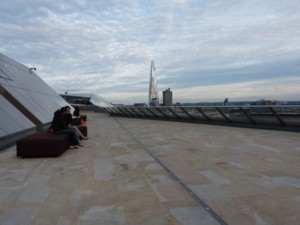




I have a feeling the warning sign should probably be parsed as, “Caution: fall hazard beyond barrier. Please do not climb.” Why it doesn’t use punctuation is beyond me.
About the specialist window cleaning; I recall seeing a TV programme about the tube which showed a firm of abseiling window cleaners working on the glass canopy over Canary Wharf station. A quick Google suggests the trade is booming, as you presume it might be.
I was going to suggest that someone may develop a window cleaning robot to save on the undoubtedly large labour cost (and Health and Safety compliance costs) of abseiling; but another Google indicates work is well under way.
I visited 1 NC a few weeks after it opened and was very unimpressed.
If you aren’t after 101 varieties of trendy coffee shop there is nothing there for you.
The viewing platform is clearly an afterthought which should have been 10ft higher – or at least a 10ft higher subplatform should have been added.
I have not even thought of returning, not even once.